Title: Combining Morphology and Palaeogenomics to Understand the Status and Contribution of Mules to Roman Equine Populations in Austria and Germany (short title: Mules Contribution to Equine Population in Austria and Germany)
Principal Investigators: International Austrian (FWF) - German Research Foundation (DFG) Joint Research Project
Elmira Mohandesan, University of Vienna, Austria & Joris Peters, LMU Munich, Munich, Germany
Abstract: In ancient cultures humans and animals interacted in multiple ways, but tangible evidence illustrating this relationship is limited due to the nature of the archaeological record usually comprising but the skeletal remains of the animals exploited in former times. Since materials relevant to the study of the human-animal relationship have often been studied using traditional methods, innovative analytical approaches must be applied to gain additional insights. In our research project an elusive animal takes centre stage, namely the mule. Representing the offspring of a male donkey and a mare, this hybrid distinguishes itself from parental stock by its greater physical strength, endurance, surefootedness in mountainous terrain, more balanced temper and modest food demands. These characteristics explain why even today mules are considered excellent labour animals and particularly suitable for long-distance transportation of people and goods. Valued since Antiquity in military and civil life in the Mediterranean region, our study addresses the issue to which extent mules became an integral part of the animal world following the Roman conquest and occupation of the regions north of the Alpine divide. Earlier research already argued that mules were introduced to the Roman Provinces Raetia, Noricum and Upper Pannonia, but failed to provide answers concerning the magnitude of this new development as well as the issue whether mules were intentionally bred north of the Alps. By refining morphological analysis applying Geometric Morphometrics and evaluating ancient DNA signatures in pre-Roman and Roman equine populations, our project intends for the first time approximating the role of this hitherto largely invisible livestock species in temperate Europe whilst in the meantime elucidating its military, economic and breeding history in Roman times.
Project number: I 3838-B29
Duration: 36 months
Call: International Austrian (FWF) - German Research Foundation (DFG) Joint Research Project
Leading Agency: FWF
Austrian project leader: Dr. Elmira Mohandesan
German project leader: Prof. Joris Peters
Mules contribution to Equine Population in Austria & Germany
01.06.2019


Dr. Elmira Mohandesan
